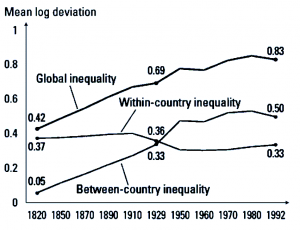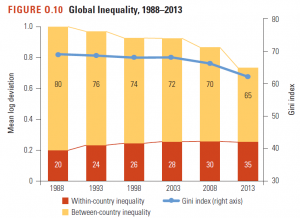By Rory Horner and David Hulme, Global Development Institute
The study and practice of international development has generally referred to the differences between ‘developed’ and ‘developing’ countries. Growing inequality between developed and developing states during the 19th and 20th centuries presented a clear task; to address the challenges faced by a relatively synonymous poor people living in poor countries.
But for the last 30 years inequality between countries have been steadily reducing, yet our development challenges remain greater than ever. Our analysis of the new geographies of 21st century development (recently published in Development and Change ), highlights the need for a shift away from the idea of ‘international’ development, recognising a new form of ‘global’ development.
Growing Importance of Income Inequalities between Countries in 19th and 20th Centuries
In 2016 the World Bank declared that it will no longer distinguish between developed and developing countries in its annual World Development Indicators. This follows on from the Sustainable Development Goals, agreed in 2015, being formulated for all, not just ‘developing’, countries. Moreover, the Paris Agreement on climate change (finalised in December 2015) requires commitments involving all countries.
Should the Global South still be seen as the key, or even only locus of development challenges, or do debates on development (alongside associated research and practice) need to give greater attention to inequalities within the Global North?
Our new paper systematically explores the changing composition of global inequalities across economic, human and environmental indicators. As prominently highlighted recently in recent research on global inequality, by Francois Bourguignon, Branko Milanovic, and in The World Bank’s 2016 Taking on Inequality Report), income inequality across all individuals in the world has fallen over the last couple of decades – the first such decline since the industrial revolution two centuries ago.
A variety of other indicators also indicate considerable progress on economic indicators. The total numbers and also the share of the world population living in extreme poverty have fallen dramatically. The total share of population in the Global South who have a daily consumption level of less than $1.90 has fallen from 49.2% in 1990 to 13.4% in 2013, with a corresponding increase in those with greater than $5 per day in consumption.
The share of the world’s countries officially designated (by the World Bank) as being low-income has fallen by more than half since 2000. The number of countries who are highly dependent on aid has fallen significantly. In the early 1990s almost half of all low & middle-income countries (L&MICs) received more than 9% of their GNI from Overseas Development Assistance, which had dropped to less than 30 countries in 2015. Global middle classes are increasingly referred to, while developing countries’ share of people listed on the Forbes World Billionaires List has increased from 16.7% in 2001 to 37.1% in 2016.
Looking beyond economic indicators, the gap in average basic health indicators, including life expectancy and mortality rates between countries is reducing. At 69.6 years, average life expectancy in low and middle-income countries in 2014, is just over 10 years less than today’s high-income countries (HICs) and a year greater than those countries average in 1960. The overall under-5 mortality rate per 1000 live births in L&MICs has fallen to one-quarter of its 1960 level, and has now reached the level the current HICs were at then. The classic binary association of non-communicable diseases such as heart disease, diabetes and cancer with developed countries has broken down.
Global primary school enrolment is approaching universal coverage, while the average person in a developing country now receives more years of schooling than the average person in a developed country did in 1960. Although higher carbon emissions have been associated with the Global North, 2005 was the first year where total carbon emissions from L&MICs countries exceeded those from HICs.
Yet claims of global convergence are misplaced in a world where development inequalities are still profound. Substantial gaps continue to exist between many people and countries in Global North and South – with considerable “citizenship premiums” for those living in the North. Educational attainment rates considerably lag educational enrolment. Carbon emissions per capita continue to show big differences, as do consumption rather than production-based emissions. Absolute income gaps between the richest and poorest deciles of the world’s population have grown. Moreover, inequalities within many countries have been growing.
Some reductions in between-country inequalities are overshadowed by vast, and often growing, inequalities between people who are near-neighbours, living in the same localities, nations, and regions. Across wealth, income and consumption and evident in both North and South, rising inequalities within countries have been highlighted in, for example, the 2016 World Social Science Report, with both the World Bank’s Taking on Inequality and the International Monetary Fund warning of the consequences. In relation to income, inequality expert Francois Bourguignon has suggested that we could “be witnessing a partial substitution of inequality within countries for the inequality between countries”. Moreover, global wealth inequalities appear higher than income inequalities and are focused within (rather than between) country differences. Populations living precariously have been increasingly identified in the Global North and South.
While it is difficult to tell whether within-country differences in health have increased, those differences remain. The gaps within many OECD countries in educational attainment are greater than those between OECD and non-OECD countries. In relation to the environment, Lucas Chancel and Thomas Piketty have attempted to estimate global carbon inequalities and have suggested that within and between country inequalities are equal.
What about the future? Thomas Piketty has notably stated that “all signs are that this phase of divergence in per capita output is over and that we have embarked on a period of convergence” between rich and poor countries. Even if within-country inequalities stay the same, the relative share of global inequalities may increase. Such a trend is of significance given that people often weight within-country inequalities with particular importance.
The blurring of the boundaries between ‘developed’ and ‘developing’ countries in the 21st century and the massive inequalities which nonetheless remain, both between and within countries, are powerful reasons to question an emphasis on developing countries seeking to become like developed countries. Moreover, such trends render questionable macro-continental generalisations about development as manifest in terms such as developed/developing worlds, pointing to the need to explore differentiation within closer spatial proximity.
The new geographies of development outlined prompt the need to shift from international development to global development. Development which is global in scope requires attention to two key types of challenges:
- collective challenges of global public goods, such as climate, global health, finance
- shared challenges that countries in both North and South face, including inequality and relative poverty, cities, socio-spatial inequalities, precarious work.
Clearly, however, not all challenges are equal. As such, the Global South still arguably warrants a key, although not exclusive, focus. Issues such as climate change are also severe development challenges with particular relevance for high-income populations.
Table 2. From International Development to Global Development
| ISSUE | International Development – ‘Divergence, big time’ | Global Development – ‘Converging divergence’ |
| Geographic focus | Place-specific: synonymous ‘poor countries’, ‘poor people’ and Global South | Universal: Sustainable development issues wherever they exist – Interconnected (e.g. global public goods) and shared (in both North and South) challenges |
| Spatial Nomenclature | First-Second-Third Worlds; Developed/Developing; Global North–South | Global convergence, national and sub-national divergence (enclaves, peripherality, connectivity/exclusion) |
| Prominent Meaning of Development | Modernisation and growth: Southern countries becoming like the Global North | SDG agenda: Transformation, true “global development”; sustainability; social justice |
| Big ‘D’ Development Morality and Actors | Charity and development aid by Northern states, NGOs | Development cooperation by traditional and new donors; multiple domestic and international sources of public and private development finance |
Source: Authors’ construction
Planet Earth approaching 2020 is a very different place even when compared with the turn of the Millennium. With a very different socio-spatial manifestation of development prevailing, the task now – for scholars, policymakers, activists, and citizens – is to understand and work towards addressing 21st century global development challenges.
This ‘global development’ still requires much more teasing out. A workshop we held last summer made a preliminary attempt at unpacking some debates around global development and we’re planning a small conference for summer 2018 which will explore the possibilities of global development across a number of key research themes.
Links:
Converging divergence working paper blog




Trackbacks/Pingbacks